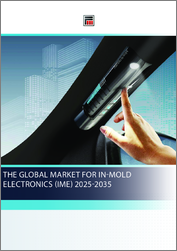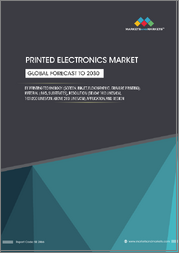
|
시장보고서
상품코드
1628907
세계의 인몰드 일렉트로닉스(IME) 시장(2025-2035년)The Global Market for In-mold Electronics (IME) 2025-2035 |
||||||
인몰드 일렉트로닉스(IME)는 플라스틱 전자공학이라고도 불리는데, 전통적인 사출 성형과 인쇄 전자공학을 결합한 혁신적인 기술입니다. 이 공정은 터치 센서, 디스플레이, 조명과 같은 기능성 전자 소자를 성형 공정에서 플라스틱 부품에 직접 내장할 수 있습니다. IME 기술은 터치 센서, 조명 및 기타 전자 기능을 3D 성형 표면에 내장하여 제조 공정을 간소화하고 조립 비용을 절감할 수 있는 스마트한 표면과 복잡한 전자 기능을 한 번의 제조 공정으로 만들 수 있습니다. 이는 제품의 성능을 향상시킬 뿐만 아니라 외부 부품이 필요하지 않기 때문에 외관을 개선할 수 있습니다.
IME의 장점은 다음과 같습니다.
- 설계 유연성 : IME은 기존의 전자기기 통합 방식으로는 불가능했던 복잡한 형태와 설계를 가능하게 합니다.
- 내구성 : 전자부품은 성형된 플라스틱 안에서 보호되기 때문에 마모와 환경적 요인에 대한 저항력이 강합니다.
- 비용 효율성 : 여러 기능을 하나의 구성요소에 통합함으로써 IME는 조립 비용을 절감하고 제조 효율성을 향상시킬 수 있습니다.
IME 기술에는 일반적으로 세 가지 단계가 있습니다.
- 전자 회로 인쇄 : 이 단계에서는 전도성 잉크를 도포하여 필요한 전자 회로를 형성합니다.
- 성형 : 이 공정은 전자 회로가 최종 제품에 원활하게 들어갈 수 있도록 하는 데 중요합니다.
- 성형 : 마지막으로 성형된 회로는 성형 부품에 봉입되어 자동차 내장재, 소비자 전자제품, 의료기기 등 다양한 용도에 사용할 수 있는 내구성과 기능성이 뛰어난 전자부품이 됩니다.
IME 제품은 공간 절약과 경량화가 중요한 자동차, 소비자 전자제품, 의료기기 등의 산업에서 특히 유용합니다. 이 기술은 제품 설계를 개선할 뿐만 아니라, 개별 전자부품의 조립을 없애 내구성과 성능을 향상시키고, 사용자 친화적인 인터페이스와 복잡한 전자 시스템을 하나의 성형된 부품으로 구현할 수 있도록 도와줍니다. 스마트 커넥티드 디바이스에 대한 수요 증가에 대응할 수 있도록 설계되었으며, 제조업체는 경쟁이 치열한 시장에서 제품을 혁신하고 차별화할 수 있습니다.
이 보고서는 빠르게 성장하는 세계 인몰드 일렉트로닉스(IME) 시장에 대해 상세히 분석하여 주요 동향, 기술, 재료, 용도, 2025-2035년 시장 전망 등을 제공합니다.
목차
제1장 주요 요약
- 표면상 설계 제한
- 용도
- IME 제조
- 투자
- 지속가능성
- 시장 전망
- 시장 예측
제2장 소개
제3장 IME 제조
- IME 컴포넌트
- IME 생산
- 구현 접근법
- 기타 생산 방법
- 기능성 필름 접착
- 금속화 방법
- MID 기술
- 다기능 복합재료
- 적층 가공
제4장 IME 컴포넌트의 통합
- 정전용량 센싱 기술
- 조명
- 촉각
- 3D 디스플레이
- 안테나
제5장 IME용 재료
- 개요
- 전도성 잉크
- 유전성 잉크
- 전도성 접착제
- 투명 전도성 재료
- 기판, 열가소성 재료
제6장 IME 시장
- 자동차
- 개요
- 상업 용도
- 세계 시장 예측
- 백색가전
- 개요
- 용도
- 세계 시장 예측
- 의료기기
- 개요
- 용도
- 세계 시장 예측
- 산업
- 개요
- 용도
- 웨어러블 일렉트로닉스
- 개요
- 용도
- 기타 시장과 용도
제7장 기업 개요
제8장 참고문헌
ksm 25.01.31In-mold electronics (IME), also sometimes known as plastronics, is an innovative technology that combines traditional injection molding with printed electronics. This process allows for the embedding of functional electronic elements, such as touch sensors, displays, and lighting, directly into plastic components during the molding process. This process allows for the creation of smart surfaces and complex electronic functionalities within a single manufacturing step. IME technology enables the embedding of touch sensors, lighting, and other electronic functionalities into 3D molded surfaces, resulting in streamlined manufacturing processes and reduced assembly costs. This not only enhances product performance but also improves aesthetics by removing the need for external components.
The advantages of IME include:
- Design Flexibility: IME enables the creation of complex shapes and designs that are not possible with traditional electronics integration methods.
- Durability: The electronic components are protected within the molded plastic, making them more resistant to wear and environmental factors.
- Cost Efficiency: By integrating multiple functions into a single part, IME can reduce assembly costs and improve manufacturing efficiency.
IME technology typically involves a three-step process:
- Printing of Electronic Circuits: This step includes the application of conductive inks to create the necessary electronic pathways.
- Forming: The printed circuits are then formed into the desired shape, which is crucial for ensuring that the electronics fit seamlessly into the final product.
- Molding: Finally, the formed circuits are encapsulated within a molded part, creating a durable and functional electronic component that can be used in various applications, such as automotive interiors, consumer electronics, and medical devices.
IME products are particularly beneficial in industries such as automotive, consumer electronics, and medical devices, where space and weight savings are critical. The technology not only enhances product design but also improves durability and performance by eliminating the need for separate electronic assemblies, enabling the creation of user-friendly interfaces and complex electronic systems within a single molded part. IME products are designed to meet the growing demand for smart, connected devices, enabling manufacturers to innovate and differentiate their offerings in competitive markets.
"The Global Market for In-Mold Electronics (IME) 2025-2035" provides an in-depth analysis of the rapidly growing global in-mold electronics (IME) market, examining key trends, technologies, materials, applications, and market forecasts from 2025 to 2035. The study offers detailed insights into this transformative technology that integrates electronic functionality directly into molded plastic components, revolutionizing manufacturing across multiple industries. The report provides extensive coverage of IME manufacturing processes, including detailed analysis of production methods, component integration, and material requirements. Key focus areas include surface functionalization technologies, conductive inks, transparent conductors, and substrate materials essential for successful IME implementation.
Market analysis covers major application sectors including:
- Automotive human-machine interfaces
- White goods and appliances
- Medical devices
- Industrial controls
- Wearable electronics
The study examines critical aspects of IME technology including:
- Manufacturing processes and requirements
- Component integration strategies
- Materials development and selection
- Quality control and testing
- Regulatory considerations
- Sustainability aspects
Technical coverage includes detailed analysis of:
- Conductive ink formulations
- Transparent conductive materials
- Substrate and thermoplastic selection
- Integration of electronic components
- Surface treatment technologies
- Testing and validation methods
The report features comprehensive market data including:
- Market size and growth projections (2025-2035)
- Revenue forecasts by application sector
- Regional market analysis
- Technology adoption trends
- Competitive landscape assessment. The report profiles leading companies across the IME value chain, including Canatu, CHASM Technologies, Covestro, Dupont, E2IP Technologies, Elantas, Embega, FORVIA Faurecia, Genes'Ink, Henkel, Kimoto, Nissha, TactoTek Oy, and more. These companies represent various segments of the IME industry including material suppliers, equipment manufacturers, technology developers, and end-product manufacturers.
Special focus is placed on emerging technologies and innovations:
- Advanced material developments
- Novel manufacturing processes
- Integration strategies
- Future technology roadmaps
- Market opportunities and challenges
TABLE OF CONTENTS
1. EXECUTIVE SUMMARY
- 1.1. Design limitations on surfaces
- 1.2. Applications
- 1.3. IME manufacturing
- 1.4. Investments
- 1.5. Sustainability
- 1.6. Market outlook
- 1.7. Market forecasts
2. INTRODUCTION
- 2.1. Functionality Integration
- 2.2. 3D Electronics
- 2.3. IME Value Chain
3. IME MANUFACTURING
- 3.1. IME components
- 3.2. IME production
- 3.3. Implementation approaches
- 3.3.1. Hybrid
- 3.3.2. One-film vs two-film
- 3.3.3. Implementation of multilayer circuits
- 3.3.4. Integration of integrated circuits in IME
- 3.3.5. Print-then-plate
- 3.3.6. Automation
- 3.3.7. Transfer printing technology
- 3.3.8. Evaporated line technology
- 3.3.9. Capacitive touch functionality
- 3.4. Other manufacturing methods
- 3.5. Functional film bonding
- 3.6. Metallization Methods
- 3.7. MID technology
- 3.7.1. Aerosol deposition
- 3.7.2. Laser Direct Structuring (LDS)
- 3.7.3. Two shot molding
- 3.7.4. 3D surfaces
- 3.7.5. Impulse printing technology
- 3.7.6. Pad printing
- 3.7.7. Spray metallization
- 3.8. Multifunctional composites
- 3.9. Additive manufacturing
4. IME COMPONENTS INTEGRATION
- 4.1. Capacitive sensing technology
- 4.1.1. Overview
- 4.1.2. Operation
- 4.2. Lighting
- 4.3. Haptics
- 4.4. 3D Displays
- 4.5. Antenna
5. MATERIALS FOR IME
- 5.1. Overview
- 5.2. Conductive inks
- 5.2.1. Materials
- 5.2.2. Stretchable inks
- 5.2.3. Inks for IME
- 5.3. Dielectric inks
- 5.4. Electrically conductive adhesives
- 5.5. Transparent conductive materials
- 5.5.1. Overview
- 5.5.2. Types
- 5.5.3. Carbon nanotube (CNT) films
- 5.5.4. Poly(3,4-ethylenedioxythiophene) polystyrene sulfonate (PEDOT:PSS)
- 5.5.5. Carbon nanobuds
- 5.5.6. Metal mesh
- 5.6. Substrate and thermoplastic materials
6. MARKETS FOR IME
- 6.1. Automotive
- 6.1.1. Overview
- 6.1.2. Commercial applications
- 6.1.2.1. Sensing
- 6.1.2.2. Headlamp covers
- 6.1.2.3. Steering Wheel
- 6.1.3. Global market forecast
- 6.2. White Goods
- 6.2.1. Overview
- 6.2.2. Applications
- 6.2.3. Global market forecast
- 6.3. Medical Devices
- 6.3.1. Overview
- 6.3.2. Applications
- 6.3.3. Global market forecast
- 6.4. Industrial
- 6.4.1. Overview
- 6.4.2. Applications
- 6.5. Wearable Electronics
- 6.5.1. Overview
- 6.5.2. Applications
- 6.6. Other Markets and Applications



















